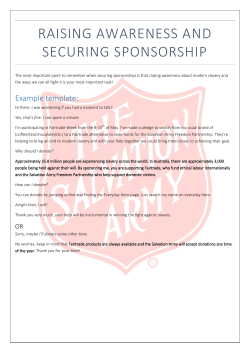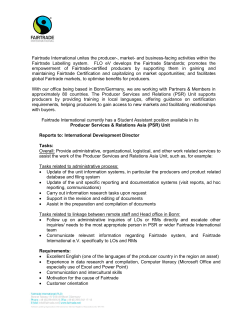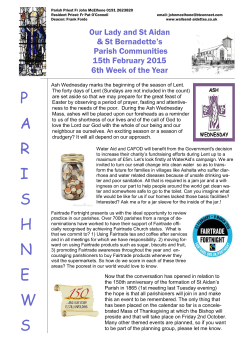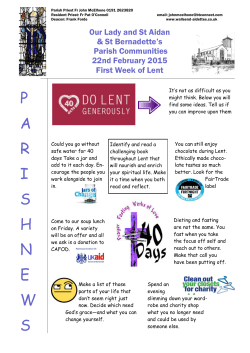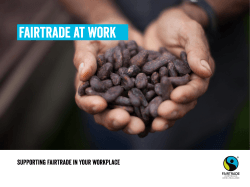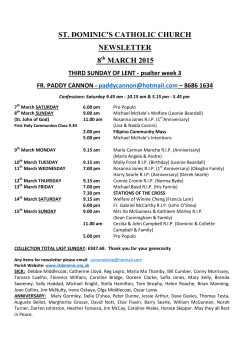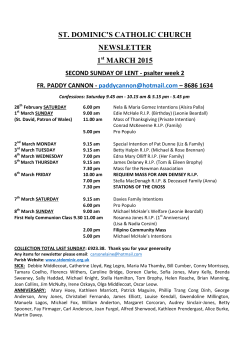
Alternative learner audit (for 3-7 yr olds and SEN
Alternative Learner Audit • Pablo the Super Banana’s Activity and Guide Please begin by filling in the below: This is the Alternative Learner Audit guide and tally sheet for children aged 3-7 years, SEN learners and those for who the Alternative Learner Audit is more appropriate than the Standard Learner Audit. The audit is an important part of your group’s Fairtrade journey and one step towards the FairAware Award, the first of three Fairtrade Schools Awards. Find out more about the awards at schools. fairtrade.org.uk/fairtrade-schools You can decide how many children you want to do the audit but in order to complete the FairAware Award, you will need to include at least 30 children in a primary school, or at least 12 children in a nursery, special school or other setting. If this isn’t possible, please get in touch at schools@fairtrade.org.uk for support. How to complete the Alternative Learner Audit Step 1: If you haven’t already, register your school, pre-school, nursery or other group at schools.fairtrade.org. uk/fairtrade-schools/becomefairtrade-school and get a login and password for the Fairtrade Schools Awards, plus updates and support. Step 2: Follow this guide with each group of children and take part in the fun, simple activities provided to help assess where your children are with their understanding of Fairtrade. Step 3: Use the completed guide to fill in the Alternative Learner Audit form online. Log in with your login and password. When you’re ready, you can complete the rest of the FairAware Award. Step 4: Keep this safe and do it again after your Fairtrade teaching or projects to review what progress has been made. Find out how the review can be part of your FairAchiever Award at schools.fairtrade.org.uk/ fairtrade-schools 1. How many children in the group? 2. What is their age range? to years Pablo the Super Banana’s activities: Before you start the audit, you could use the PowerPoint available at schools. fairtrade.org.uk/pablo. This will help when taking children through the audit activities. You can ask children various questions and open up explorations that are best for your group, but the following questions need to be covered as part of the audit: Show children a bunch of Fairtrade bananas (you can use the image in the PowerPoint or an actual bunch). 1.Do you know where bananas come from? (Please indicate the numbers who say ‘yes’ or ‘no’) Yes: No: 2. If children have answered yes, ask them to tell you where they come from (Tally their responses if they respond as follows) children said they grow on trees children said they come from a different country children said they are grown by farmers 3.Ask children if they can see the FAIRTRADE Mark (either on the bananas or the PowerPoint). Have you seen this before? Hands up if you have (Tally the numbers for yes and no answers) Yes: No: 4.Where have you seen this sign before? (Tally the responses) children could explain where they have seen it before 5.Do you know what it means? (Please indicate how many children could give a very simple explanation or key word for Fairtrade, for example ‘it makes farmers/ growers happy’, ‘it helps farmers/growers’, ‘it’s fair’, it’s good for farmers/growers’ or key words such as fair, help, happy, farmer etc). children could say a word or give a short explanation for Fairtrade 1 Alternative Learner Audit • Pablo the Super Banana’s Activity and Guide Tell the Pablo the Super Banana story using the story cards. You can use the PowerPoint at the same time to help aid understanding of where a banana comes from After telling the story: 6. Spot the difference Show children 4-6 items that are both Fairtrade and non-Fairtrade. You can use the images provided in the pack (for the trolley shop game) or use items bought from a shop. For example: • Fairtrade and non-Fairtrade bananas • Fairtrade and non-Fairtrade chocolate bars • Fairtrade and non-Fairtrade rice Ask children to compare each set of products and spot the differences. Can they spot the FAIRTRADE Mark? Item 1: children spotted the FAIRTRADE Mark Item 4: children spotted the FAIRTRADE Mark Item 2: children spotted the FAIRTRADE Mark Item 5: children spotted the FAIRTRADE Mark Item 3: children spotted the FAIRTRADE Mark Item 6: children spotted the FAIRTRADE Mark 7. Trolley shop game Give each child a trolley sheet. The children can colour in and cut out the food images. Have all the food images laid out in the middle of the circle and tell children they can go shopping for five things and put them ‘in’ their trolleys. Ask them to think about Pablo the Super Banana’s story and how their shopping can be FAIR and HELP farmers. children put Fairtrade items in their trolley, knowing they are ‘fair’ or make the farmers ‘happy’ or ‘help’ the farmers? children didn’t know: 8. The home activity booklets enclosed in your pack are for children to take home to continue their Fairtrade learning with family. The booklet is something children can be encouraged to stick in their home book or be displayed in your setting as a great example of home learning. a. How many home activity booklets did you send home? b. How many did you get back (in a home book or used in a display etc)? 2
© Copyright 2025
